Seven Group Holdings: Advanced Financial Accounting Assignment Report
VerifiedAdded on 2022/10/14
|11
|3073
|371
Report
AI Summary
This report analyzes the financial accounting practices of Seven Group Holdings, an Australian Securities Exchange (ASX) listed company. It begins by identifying and describing the accounting concepts used by the company, with a specific focus on the going concern concept. The report then delves into the changes incorporated in the newly modified standard of accounting for leases, AASB 16, and how these changes impact Seven Group Holdings, including discussions of operating and finance leases. Furthermore, it summarizes the key disclosures made by the company regarding its accounting for leases, including the transitional provisions and the effect of the transition from the previous accounting standard, AASB 117, to AASB 16. The analysis includes the impact of the new standard on the company's financial results, position, and cash flows, as well as the anticipated changes in total assets, liabilities, and expenses. The report provides a comprehensive overview of the company's accounting practices and the implications of the new lease accounting standard.
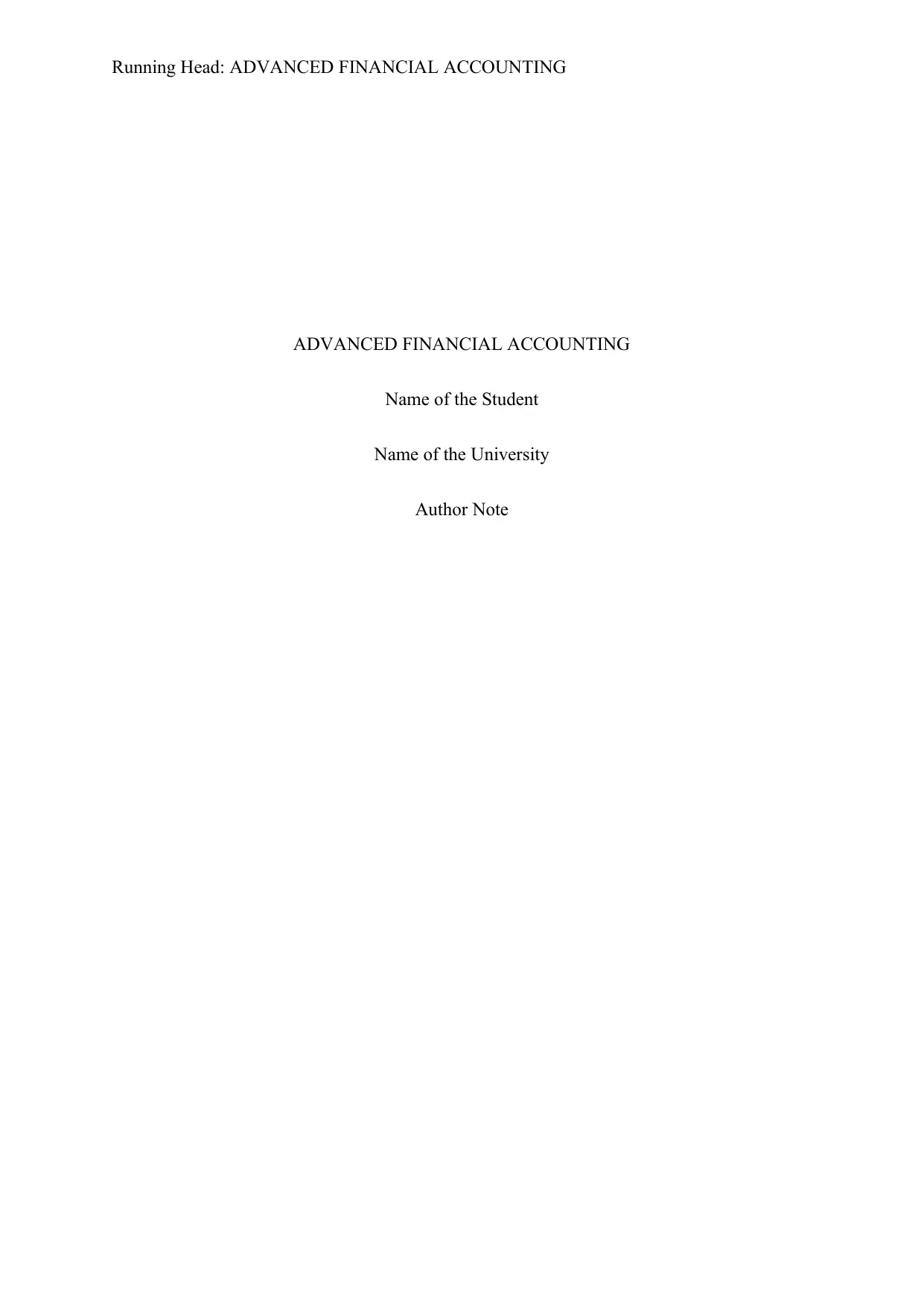
Running Head: ADVANCED FINANCIAL ACCOUNTING
ADVANCED FINANCIAL ACCOUNTING
Name of the Student
Name of the University
Author Note
ADVANCED FINANCIAL ACCOUNTING
Name of the Student
Name of the University
Author Note
Paraphrase This Document
Need a fresh take? Get an instant paraphrase of this document with our AI Paraphraser
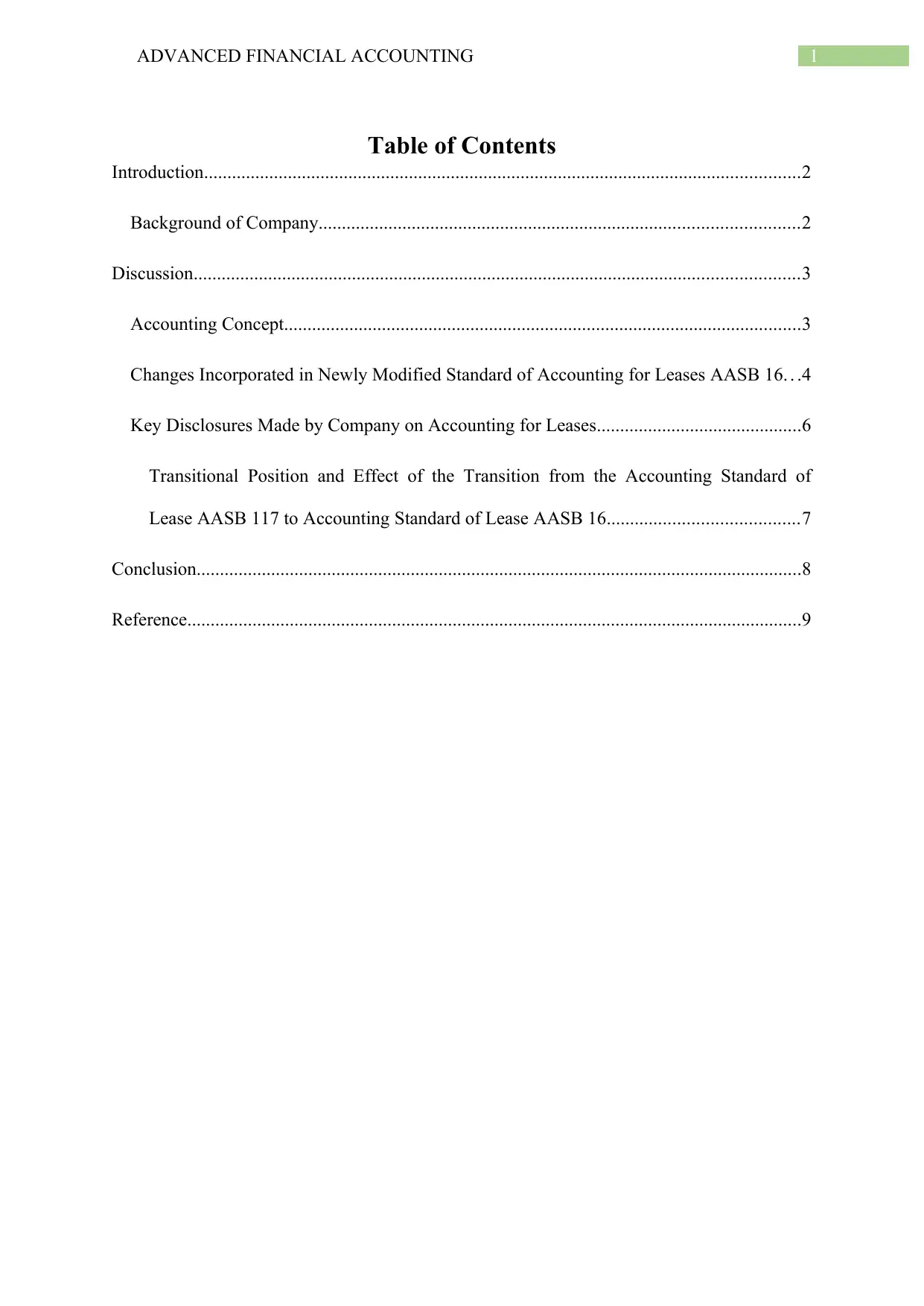
1ADVANCED FINANCIAL ACCOUNTING
Table of Contents
Introduction................................................................................................................................2
Background of Company.......................................................................................................2
Discussion..................................................................................................................................3
Accounting Concept...............................................................................................................3
Changes Incorporated in Newly Modified Standard of Accounting for Leases AASB 16. . .4
Key Disclosures Made by Company on Accounting for Leases............................................6
Transitional Position and Effect of the Transition from the Accounting Standard of
Lease AASB 117 to Accounting Standard of Lease AASB 16.........................................7
Conclusion..................................................................................................................................8
Reference....................................................................................................................................9
Table of Contents
Introduction................................................................................................................................2
Background of Company.......................................................................................................2
Discussion..................................................................................................................................3
Accounting Concept...............................................................................................................3
Changes Incorporated in Newly Modified Standard of Accounting for Leases AASB 16. . .4
Key Disclosures Made by Company on Accounting for Leases............................................6
Transitional Position and Effect of the Transition from the Accounting Standard of
Lease AASB 117 to Accounting Standard of Lease AASB 16.........................................7
Conclusion..................................................................................................................................8
Reference....................................................................................................................................9
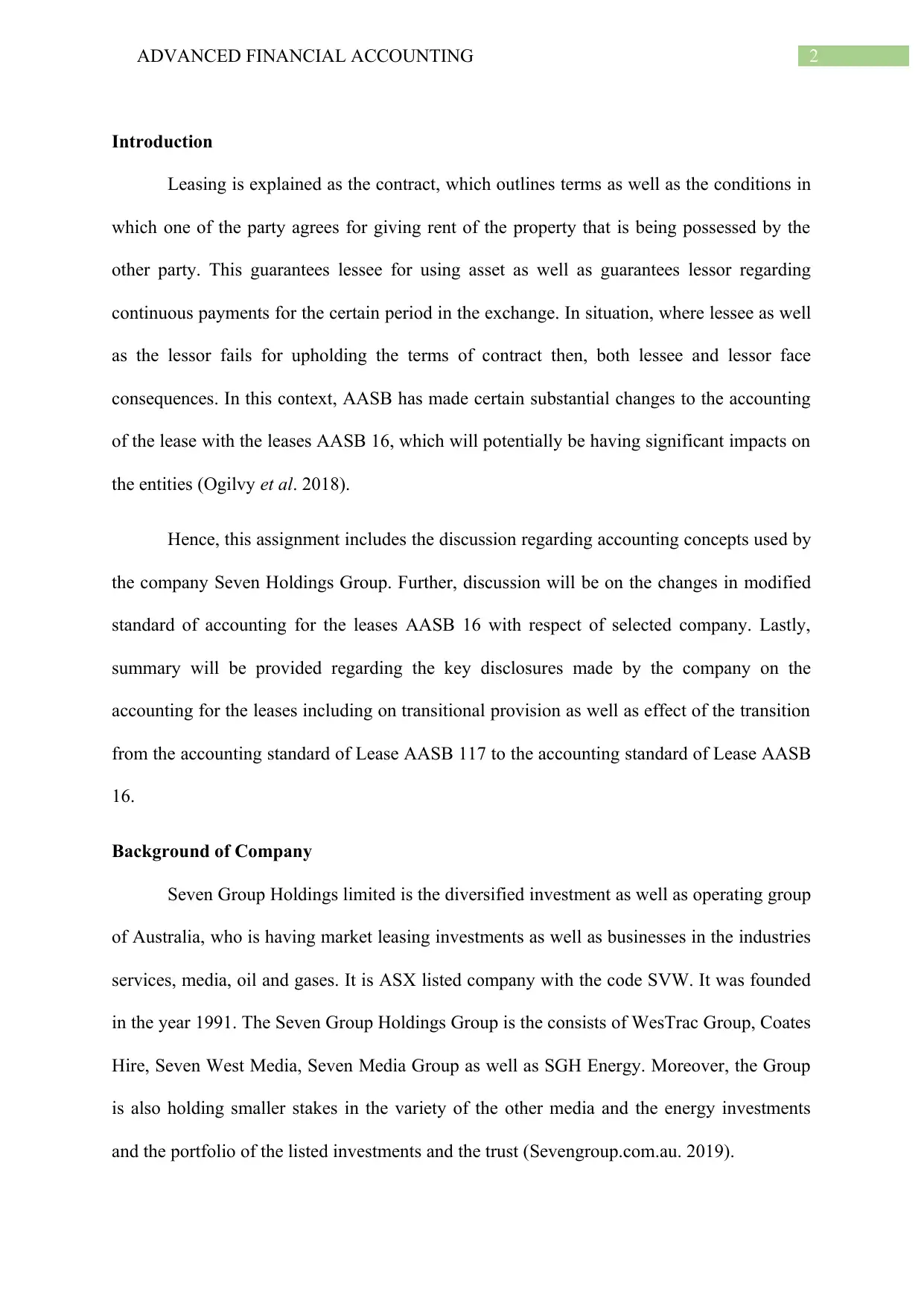
2ADVANCED FINANCIAL ACCOUNTING
Introduction
Leasing is explained as the contract, which outlines terms as well as the conditions in
which one of the party agrees for giving rent of the property that is being possessed by the
other party. This guarantees lessee for using asset as well as guarantees lessor regarding
continuous payments for the certain period in the exchange. In situation, where lessee as well
as the lessor fails for upholding the terms of contract then, both lessee and lessor face
consequences. In this context, AASB has made certain substantial changes to the accounting
of the lease with the leases AASB 16, which will potentially be having significant impacts on
the entities (Ogilvy et al. 2018).
Hence, this assignment includes the discussion regarding accounting concepts used by
the company Seven Holdings Group. Further, discussion will be on the changes in modified
standard of accounting for the leases AASB 16 with respect of selected company. Lastly,
summary will be provided regarding the key disclosures made by the company on the
accounting for the leases including on transitional provision as well as effect of the transition
from the accounting standard of Lease AASB 117 to the accounting standard of Lease AASB
16.
Background of Company
Seven Group Holdings limited is the diversified investment as well as operating group
of Australia, who is having market leasing investments as well as businesses in the industries
services, media, oil and gases. It is ASX listed company with the code SVW. It was founded
in the year 1991. The Seven Group Holdings Group is the consists of WesTrac Group, Coates
Hire, Seven West Media, Seven Media Group as well as SGH Energy. Moreover, the Group
is also holding smaller stakes in the variety of the other media and the energy investments
and the portfolio of the listed investments and the trust (Sevengroup.com.au. 2019).
Introduction
Leasing is explained as the contract, which outlines terms as well as the conditions in
which one of the party agrees for giving rent of the property that is being possessed by the
other party. This guarantees lessee for using asset as well as guarantees lessor regarding
continuous payments for the certain period in the exchange. In situation, where lessee as well
as the lessor fails for upholding the terms of contract then, both lessee and lessor face
consequences. In this context, AASB has made certain substantial changes to the accounting
of the lease with the leases AASB 16, which will potentially be having significant impacts on
the entities (Ogilvy et al. 2018).
Hence, this assignment includes the discussion regarding accounting concepts used by
the company Seven Holdings Group. Further, discussion will be on the changes in modified
standard of accounting for the leases AASB 16 with respect of selected company. Lastly,
summary will be provided regarding the key disclosures made by the company on the
accounting for the leases including on transitional provision as well as effect of the transition
from the accounting standard of Lease AASB 117 to the accounting standard of Lease AASB
16.
Background of Company
Seven Group Holdings limited is the diversified investment as well as operating group
of Australia, who is having market leasing investments as well as businesses in the industries
services, media, oil and gases. It is ASX listed company with the code SVW. It was founded
in the year 1991. The Seven Group Holdings Group is the consists of WesTrac Group, Coates
Hire, Seven West Media, Seven Media Group as well as SGH Energy. Moreover, the Group
is also holding smaller stakes in the variety of the other media and the energy investments
and the portfolio of the listed investments and the trust (Sevengroup.com.au. 2019).
⊘ This is a preview!⊘
Do you want full access?
Subscribe today to unlock all pages.

Trusted by 1+ million students worldwide
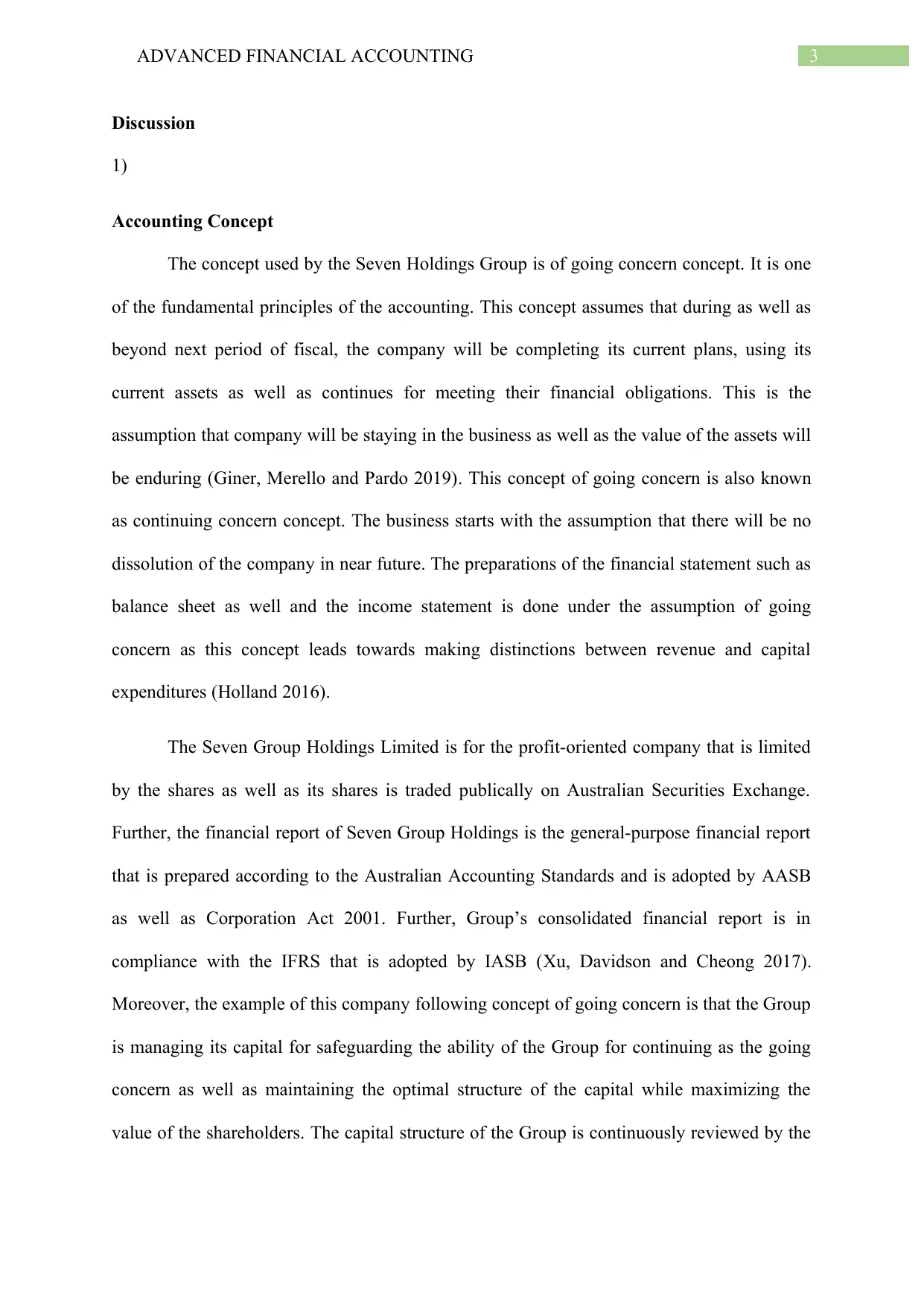
3ADVANCED FINANCIAL ACCOUNTING
Discussion
1)
Accounting Concept
The concept used by the Seven Holdings Group is of going concern concept. It is one
of the fundamental principles of the accounting. This concept assumes that during as well as
beyond next period of fiscal, the company will be completing its current plans, using its
current assets as well as continues for meeting their financial obligations. This is the
assumption that company will be staying in the business as well as the value of the assets will
be enduring (Giner, Merello and Pardo 2019). This concept of going concern is also known
as continuing concern concept. The business starts with the assumption that there will be no
dissolution of the company in near future. The preparations of the financial statement such as
balance sheet as well and the income statement is done under the assumption of going
concern as this concept leads towards making distinctions between revenue and capital
expenditures (Holland 2016).
The Seven Group Holdings Limited is for the profit-oriented company that is limited
by the shares as well as its shares is traded publically on Australian Securities Exchange.
Further, the financial report of Seven Group Holdings is the general-purpose financial report
that is prepared according to the Australian Accounting Standards and is adopted by AASB
as well as Corporation Act 2001. Further, Group’s consolidated financial report is in
compliance with the IFRS that is adopted by IASB (Xu, Davidson and Cheong 2017).
Moreover, the example of this company following concept of going concern is that the Group
is managing its capital for safeguarding the ability of the Group for continuing as the going
concern as well as maintaining the optimal structure of the capital while maximizing the
value of the shareholders. The capital structure of the Group is continuously reviewed by the
Discussion
1)
Accounting Concept
The concept used by the Seven Holdings Group is of going concern concept. It is one
of the fundamental principles of the accounting. This concept assumes that during as well as
beyond next period of fiscal, the company will be completing its current plans, using its
current assets as well as continues for meeting their financial obligations. This is the
assumption that company will be staying in the business as well as the value of the assets will
be enduring (Giner, Merello and Pardo 2019). This concept of going concern is also known
as continuing concern concept. The business starts with the assumption that there will be no
dissolution of the company in near future. The preparations of the financial statement such as
balance sheet as well and the income statement is done under the assumption of going
concern as this concept leads towards making distinctions between revenue and capital
expenditures (Holland 2016).
The Seven Group Holdings Limited is for the profit-oriented company that is limited
by the shares as well as its shares is traded publically on Australian Securities Exchange.
Further, the financial report of Seven Group Holdings is the general-purpose financial report
that is prepared according to the Australian Accounting Standards and is adopted by AASB
as well as Corporation Act 2001. Further, Group’s consolidated financial report is in
compliance with the IFRS that is adopted by IASB (Xu, Davidson and Cheong 2017).
Moreover, the example of this company following concept of going concern is that the Group
is managing its capital for safeguarding the ability of the Group for continuing as the going
concern as well as maintaining the optimal structure of the capital while maximizing the
value of the shareholders. The capital structure of the Group is continuously reviewed by the
Paraphrase This Document
Need a fresh take? Get an instant paraphrase of this document with our AI Paraphraser
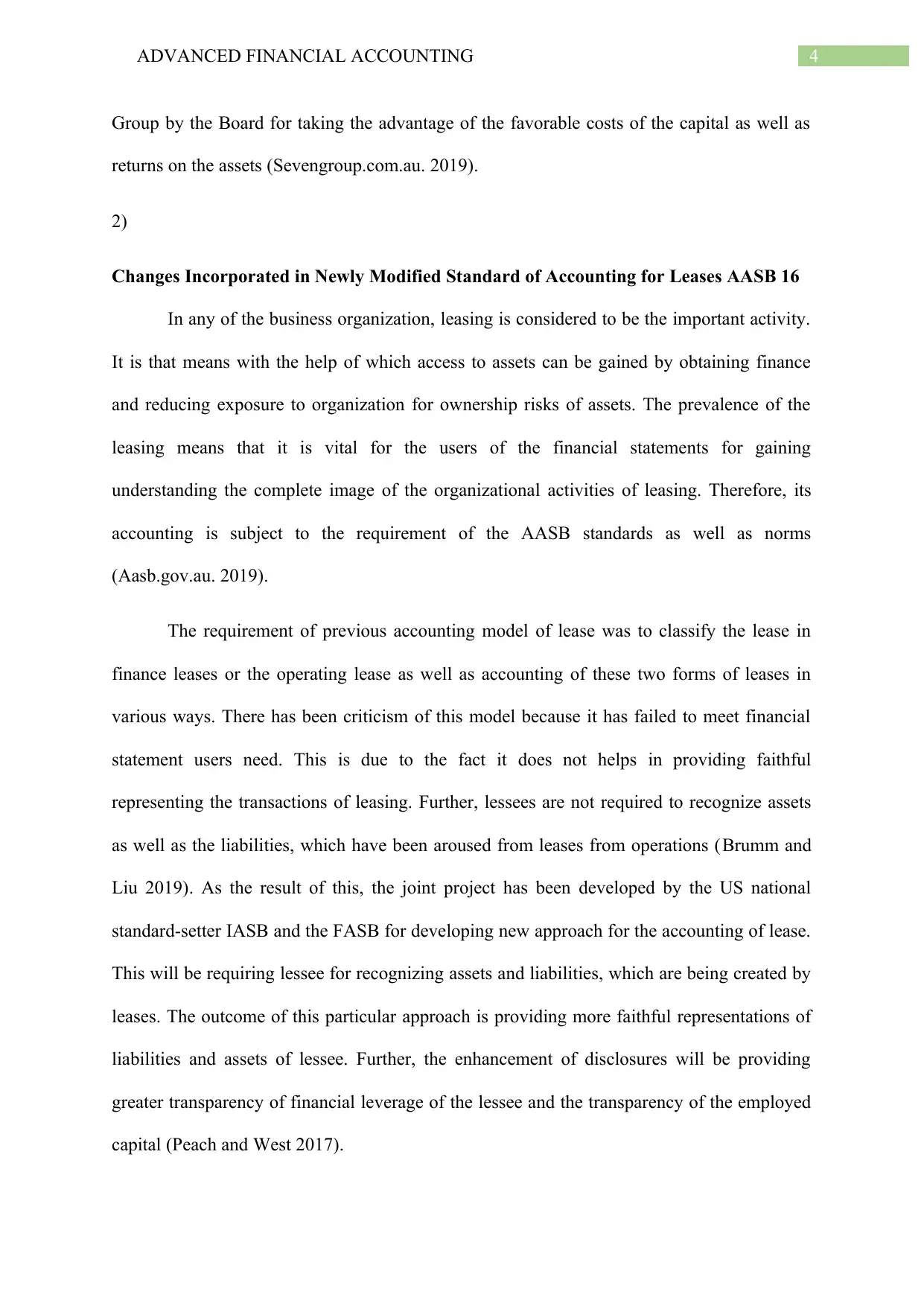
4ADVANCED FINANCIAL ACCOUNTING
Group by the Board for taking the advantage of the favorable costs of the capital as well as
returns on the assets (Sevengroup.com.au. 2019).
2)
Changes Incorporated in Newly Modified Standard of Accounting for Leases AASB 16
In any of the business organization, leasing is considered to be the important activity.
It is that means with the help of which access to assets can be gained by obtaining finance
and reducing exposure to organization for ownership risks of assets. The prevalence of the
leasing means that it is vital for the users of the financial statements for gaining
understanding the complete image of the organizational activities of leasing. Therefore, its
accounting is subject to the requirement of the AASB standards as well as norms
(Aasb.gov.au. 2019).
The requirement of previous accounting model of lease was to classify the lease in
finance leases or the operating lease as well as accounting of these two forms of leases in
various ways. There has been criticism of this model because it has failed to meet financial
statement users need. This is due to the fact it does not helps in providing faithful
representing the transactions of leasing. Further, lessees are not required to recognize assets
as well as the liabilities, which have been aroused from leases from operations (Brumm and
Liu 2019). As the result of this, the joint project has been developed by the US national
standard-setter IASB and the FASB for developing new approach for the accounting of lease.
This will be requiring lessee for recognizing assets and liabilities, which are being created by
leases. The outcome of this particular approach is providing more faithful representations of
liabilities and assets of lessee. Further, the enhancement of disclosures will be providing
greater transparency of financial leverage of the lessee and the transparency of the employed
capital (Peach and West 2017).
Group by the Board for taking the advantage of the favorable costs of the capital as well as
returns on the assets (Sevengroup.com.au. 2019).
2)
Changes Incorporated in Newly Modified Standard of Accounting for Leases AASB 16
In any of the business organization, leasing is considered to be the important activity.
It is that means with the help of which access to assets can be gained by obtaining finance
and reducing exposure to organization for ownership risks of assets. The prevalence of the
leasing means that it is vital for the users of the financial statements for gaining
understanding the complete image of the organizational activities of leasing. Therefore, its
accounting is subject to the requirement of the AASB standards as well as norms
(Aasb.gov.au. 2019).
The requirement of previous accounting model of lease was to classify the lease in
finance leases or the operating lease as well as accounting of these two forms of leases in
various ways. There has been criticism of this model because it has failed to meet financial
statement users need. This is due to the fact it does not helps in providing faithful
representing the transactions of leasing. Further, lessees are not required to recognize assets
as well as the liabilities, which have been aroused from leases from operations (Brumm and
Liu 2019). As the result of this, the joint project has been developed by the US national
standard-setter IASB and the FASB for developing new approach for the accounting of lease.
This will be requiring lessee for recognizing assets and liabilities, which are being created by
leases. The outcome of this particular approach is providing more faithful representations of
liabilities and assets of lessee. Further, the enhancement of disclosures will be providing
greater transparency of financial leverage of the lessee and the transparency of the employed
capital (Peach and West 2017).
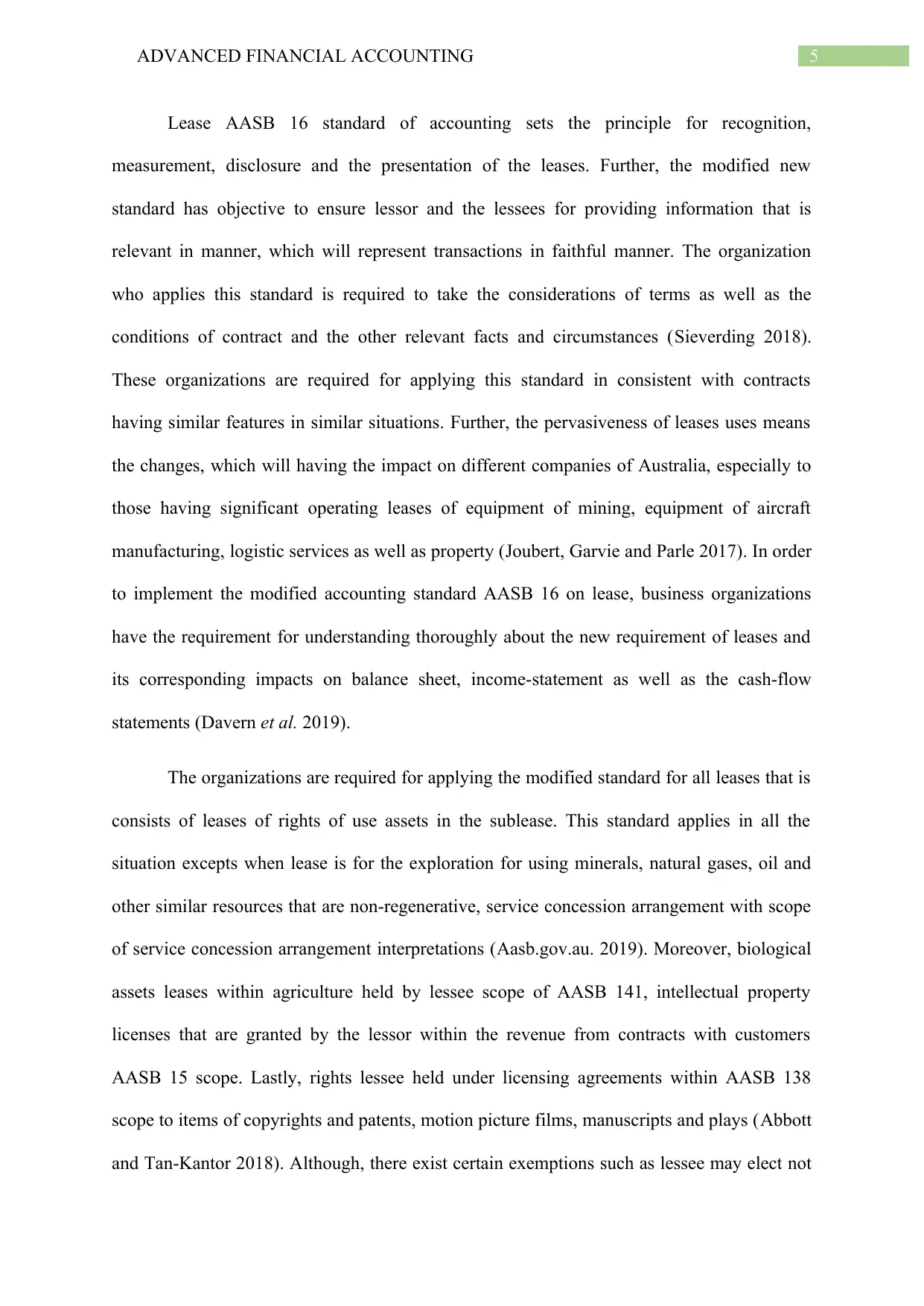
5ADVANCED FINANCIAL ACCOUNTING
Lease AASB 16 standard of accounting sets the principle for recognition,
measurement, disclosure and the presentation of the leases. Further, the modified new
standard has objective to ensure lessor and the lessees for providing information that is
relevant in manner, which will represent transactions in faithful manner. The organization
who applies this standard is required to take the considerations of terms as well as the
conditions of contract and the other relevant facts and circumstances (Sieverding 2018).
These organizations are required for applying this standard in consistent with contracts
having similar features in similar situations. Further, the pervasiveness of leases uses means
the changes, which will having the impact on different companies of Australia, especially to
those having significant operating leases of equipment of mining, equipment of aircraft
manufacturing, logistic services as well as property (Joubert, Garvie and Parle 2017). In order
to implement the modified accounting standard AASB 16 on lease, business organizations
have the requirement for understanding thoroughly about the new requirement of leases and
its corresponding impacts on balance sheet, income-statement as well as the cash-flow
statements (Davern et al. 2019).
The organizations are required for applying the modified standard for all leases that is
consists of leases of rights of use assets in the sublease. This standard applies in all the
situation excepts when lease is for the exploration for using minerals, natural gases, oil and
other similar resources that are non-regenerative, service concession arrangement with scope
of service concession arrangement interpretations (Aasb.gov.au. 2019). Moreover, biological
assets leases within agriculture held by lessee scope of AASB 141, intellectual property
licenses that are granted by the lessor within the revenue from contracts with customers
AASB 15 scope. Lastly, rights lessee held under licensing agreements within AASB 138
scope to items of copyrights and patents, motion picture films, manuscripts and plays (Abbott
and Tan‐Kantor 2018). Although, there exist certain exemptions such as lessee may elect not
Lease AASB 16 standard of accounting sets the principle for recognition,
measurement, disclosure and the presentation of the leases. Further, the modified new
standard has objective to ensure lessor and the lessees for providing information that is
relevant in manner, which will represent transactions in faithful manner. The organization
who applies this standard is required to take the considerations of terms as well as the
conditions of contract and the other relevant facts and circumstances (Sieverding 2018).
These organizations are required for applying this standard in consistent with contracts
having similar features in similar situations. Further, the pervasiveness of leases uses means
the changes, which will having the impact on different companies of Australia, especially to
those having significant operating leases of equipment of mining, equipment of aircraft
manufacturing, logistic services as well as property (Joubert, Garvie and Parle 2017). In order
to implement the modified accounting standard AASB 16 on lease, business organizations
have the requirement for understanding thoroughly about the new requirement of leases and
its corresponding impacts on balance sheet, income-statement as well as the cash-flow
statements (Davern et al. 2019).
The organizations are required for applying the modified standard for all leases that is
consists of leases of rights of use assets in the sublease. This standard applies in all the
situation excepts when lease is for the exploration for using minerals, natural gases, oil and
other similar resources that are non-regenerative, service concession arrangement with scope
of service concession arrangement interpretations (Aasb.gov.au. 2019). Moreover, biological
assets leases within agriculture held by lessee scope of AASB 141, intellectual property
licenses that are granted by the lessor within the revenue from contracts with customers
AASB 15 scope. Lastly, rights lessee held under licensing agreements within AASB 138
scope to items of copyrights and patents, motion picture films, manuscripts and plays (Abbott
and Tan‐Kantor 2018). Although, there exist certain exemptions such as lessee may elect not
⊘ This is a preview!⊘
Do you want full access?
Subscribe today to unlock all pages.

Trusted by 1+ million students worldwide
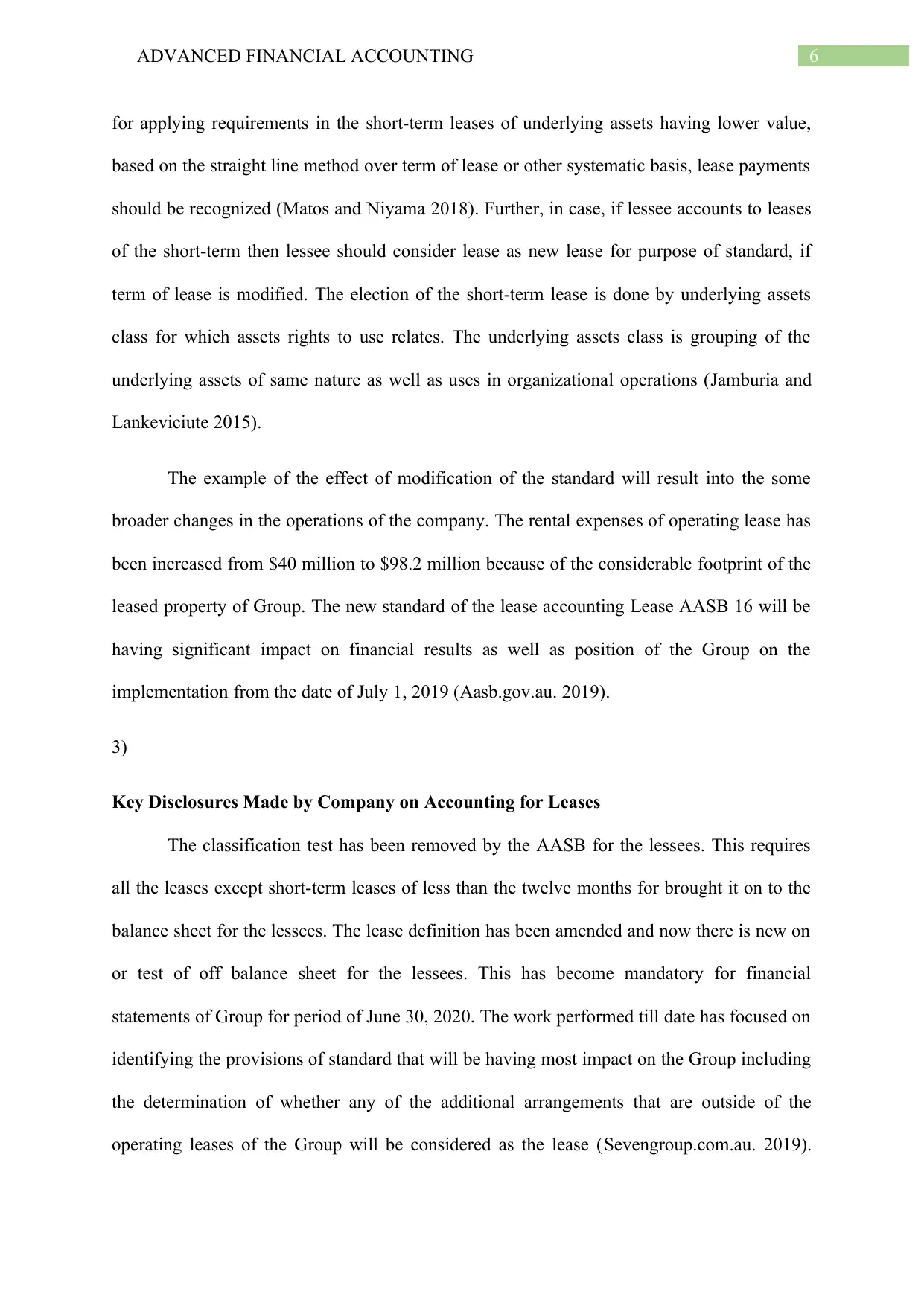
6ADVANCED FINANCIAL ACCOUNTING
for applying requirements in the short-term leases of underlying assets having lower value,
based on the straight line method over term of lease or other systematic basis, lease payments
should be recognized (Matos and Niyama 2018). Further, in case, if lessee accounts to leases
of the short-term then lessee should consider lease as new lease for purpose of standard, if
term of lease is modified. The election of the short-term lease is done by underlying assets
class for which assets rights to use relates. The underlying assets class is grouping of the
underlying assets of same nature as well as uses in organizational operations (Jamburia and
Lankeviciute 2015).
The example of the effect of modification of the standard will result into the some
broader changes in the operations of the company. The rental expenses of operating lease has
been increased from $40 million to $98.2 million because of the considerable footprint of the
leased property of Group. The new standard of the lease accounting Lease AASB 16 will be
having significant impact on financial results as well as position of the Group on the
implementation from the date of July 1, 2019 (Aasb.gov.au. 2019).
3)
Key Disclosures Made by Company on Accounting for Leases
The classification test has been removed by the AASB for the lessees. This requires
all the leases except short-term leases of less than the twelve months for brought it on to the
balance sheet for the lessees. The lease definition has been amended and now there is new on
or test of off balance sheet for the lessees. This has become mandatory for financial
statements of Group for period of June 30, 2020. The work performed till date has focused on
identifying the provisions of standard that will be having most impact on the Group including
the determination of whether any of the additional arrangements that are outside of the
operating leases of the Group will be considered as the lease (Sevengroup.com.au. 2019).
for applying requirements in the short-term leases of underlying assets having lower value,
based on the straight line method over term of lease or other systematic basis, lease payments
should be recognized (Matos and Niyama 2018). Further, in case, if lessee accounts to leases
of the short-term then lessee should consider lease as new lease for purpose of standard, if
term of lease is modified. The election of the short-term lease is done by underlying assets
class for which assets rights to use relates. The underlying assets class is grouping of the
underlying assets of same nature as well as uses in organizational operations (Jamburia and
Lankeviciute 2015).
The example of the effect of modification of the standard will result into the some
broader changes in the operations of the company. The rental expenses of operating lease has
been increased from $40 million to $98.2 million because of the considerable footprint of the
leased property of Group. The new standard of the lease accounting Lease AASB 16 will be
having significant impact on financial results as well as position of the Group on the
implementation from the date of July 1, 2019 (Aasb.gov.au. 2019).
3)
Key Disclosures Made by Company on Accounting for Leases
The classification test has been removed by the AASB for the lessees. This requires
all the leases except short-term leases of less than the twelve months for brought it on to the
balance sheet for the lessees. The lease definition has been amended and now there is new on
or test of off balance sheet for the lessees. This has become mandatory for financial
statements of Group for period of June 30, 2020. The work performed till date has focused on
identifying the provisions of standard that will be having most impact on the Group including
the determination of whether any of the additional arrangements that are outside of the
operating leases of the Group will be considered as the lease (Sevengroup.com.au. 2019).
Paraphrase This Document
Need a fresh take? Get an instant paraphrase of this document with our AI Paraphraser
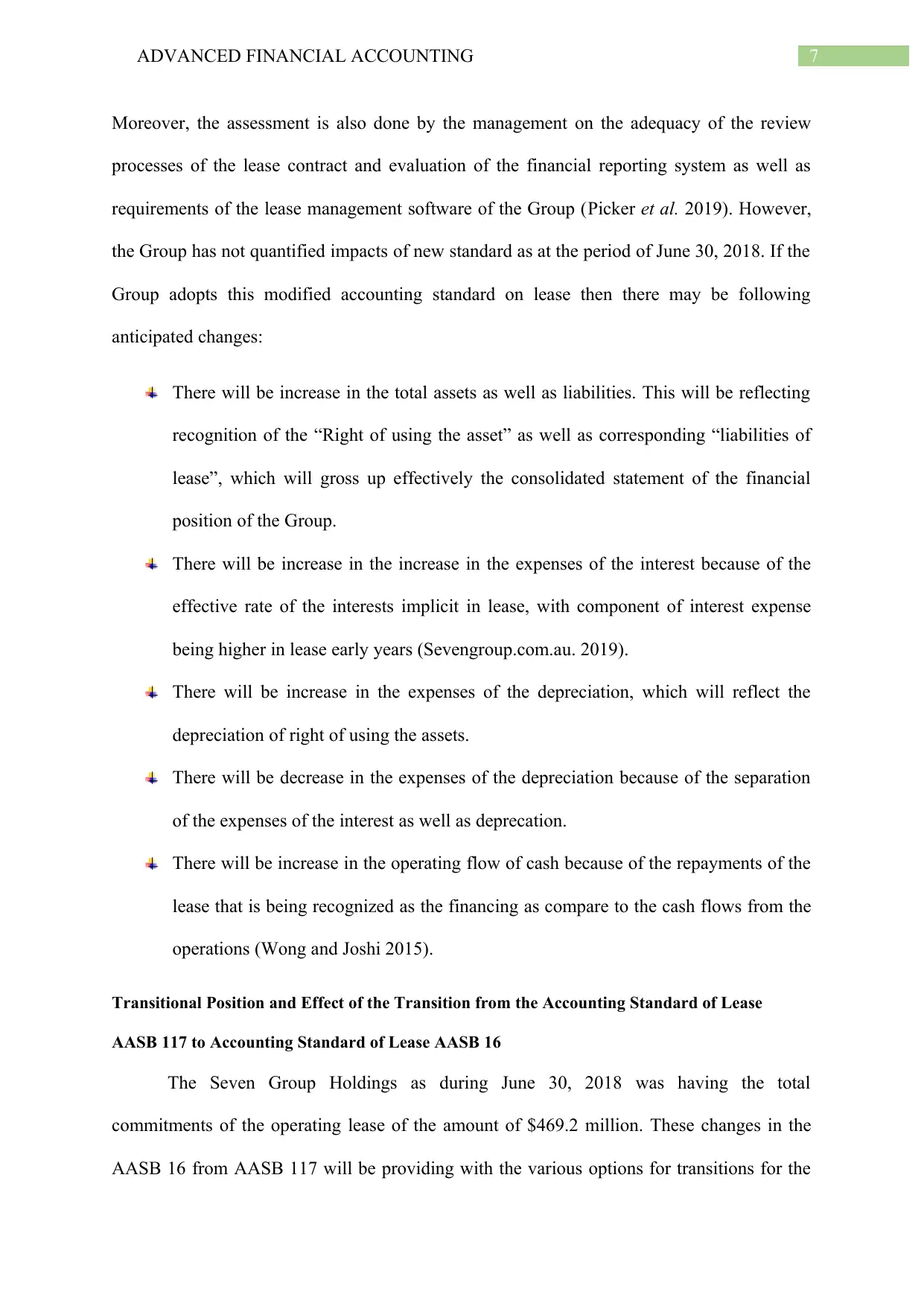
7ADVANCED FINANCIAL ACCOUNTING
Moreover, the assessment is also done by the management on the adequacy of the review
processes of the lease contract and evaluation of the financial reporting system as well as
requirements of the lease management software of the Group (Picker et al. 2019). However,
the Group has not quantified impacts of new standard as at the period of June 30, 2018. If the
Group adopts this modified accounting standard on lease then there may be following
anticipated changes:
There will be increase in the total assets as well as liabilities. This will be reflecting
recognition of the “Right of using the asset” as well as corresponding “liabilities of
lease”, which will gross up effectively the consolidated statement of the financial
position of the Group.
There will be increase in the increase in the expenses of the interest because of the
effective rate of the interests implicit in lease, with component of interest expense
being higher in lease early years (Sevengroup.com.au. 2019).
There will be increase in the expenses of the depreciation, which will reflect the
depreciation of right of using the assets.
There will be decrease in the expenses of the depreciation because of the separation
of the expenses of the interest as well as deprecation.
There will be increase in the operating flow of cash because of the repayments of the
lease that is being recognized as the financing as compare to the cash flows from the
operations (Wong and Joshi 2015).
Transitional Position and Effect of the Transition from the Accounting Standard of Lease
AASB 117 to Accounting Standard of Lease AASB 16
The Seven Group Holdings as during June 30, 2018 was having the total
commitments of the operating lease of the amount of $469.2 million. These changes in the
AASB 16 from AASB 117 will be providing with the various options for transitions for the
Moreover, the assessment is also done by the management on the adequacy of the review
processes of the lease contract and evaluation of the financial reporting system as well as
requirements of the lease management software of the Group (Picker et al. 2019). However,
the Group has not quantified impacts of new standard as at the period of June 30, 2018. If the
Group adopts this modified accounting standard on lease then there may be following
anticipated changes:
There will be increase in the total assets as well as liabilities. This will be reflecting
recognition of the “Right of using the asset” as well as corresponding “liabilities of
lease”, which will gross up effectively the consolidated statement of the financial
position of the Group.
There will be increase in the increase in the expenses of the interest because of the
effective rate of the interests implicit in lease, with component of interest expense
being higher in lease early years (Sevengroup.com.au. 2019).
There will be increase in the expenses of the depreciation, which will reflect the
depreciation of right of using the assets.
There will be decrease in the expenses of the depreciation because of the separation
of the expenses of the interest as well as deprecation.
There will be increase in the operating flow of cash because of the repayments of the
lease that is being recognized as the financing as compare to the cash flows from the
operations (Wong and Joshi 2015).
Transitional Position and Effect of the Transition from the Accounting Standard of Lease
AASB 117 to Accounting Standard of Lease AASB 16
The Seven Group Holdings as during June 30, 2018 was having the total
commitments of the operating lease of the amount of $469.2 million. These changes in the
AASB 16 from AASB 117 will be providing with the various options for transitions for the
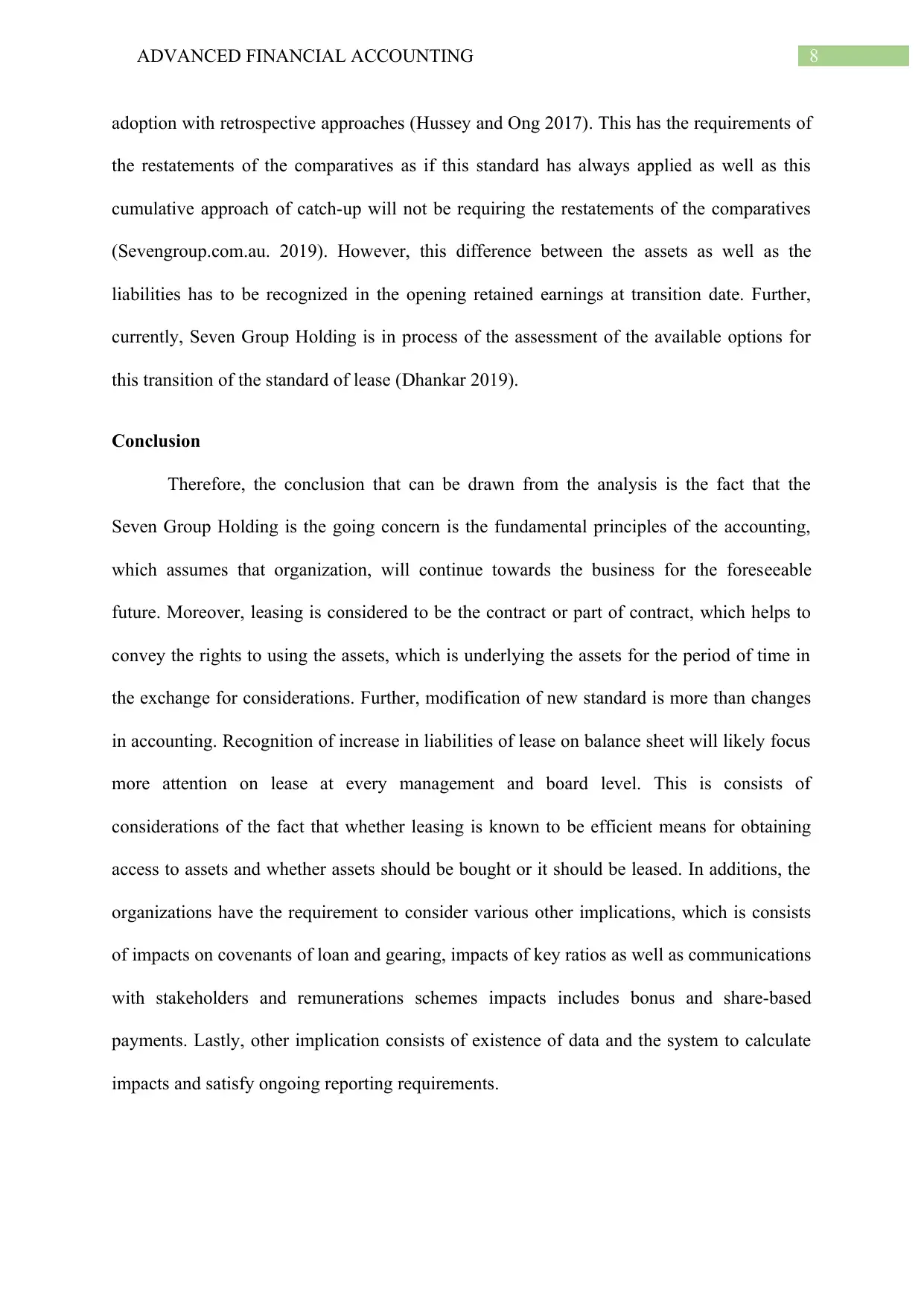
8ADVANCED FINANCIAL ACCOUNTING
adoption with retrospective approaches (Hussey and Ong 2017). This has the requirements of
the restatements of the comparatives as if this standard has always applied as well as this
cumulative approach of catch-up will not be requiring the restatements of the comparatives
(Sevengroup.com.au. 2019). However, this difference between the assets as well as the
liabilities has to be recognized in the opening retained earnings at transition date. Further,
currently, Seven Group Holding is in process of the assessment of the available options for
this transition of the standard of lease (Dhankar 2019).
Conclusion
Therefore, the conclusion that can be drawn from the analysis is the fact that the
Seven Group Holding is the going concern is the fundamental principles of the accounting,
which assumes that organization, will continue towards the business for the foreseeable
future. Moreover, leasing is considered to be the contract or part of contract, which helps to
convey the rights to using the assets, which is underlying the assets for the period of time in
the exchange for considerations. Further, modification of new standard is more than changes
in accounting. Recognition of increase in liabilities of lease on balance sheet will likely focus
more attention on lease at every management and board level. This is consists of
considerations of the fact that whether leasing is known to be efficient means for obtaining
access to assets and whether assets should be bought or it should be leased. In additions, the
organizations have the requirement to consider various other implications, which is consists
of impacts on covenants of loan and gearing, impacts of key ratios as well as communications
with stakeholders and remunerations schemes impacts includes bonus and share-based
payments. Lastly, other implication consists of existence of data and the system to calculate
impacts and satisfy ongoing reporting requirements.
adoption with retrospective approaches (Hussey and Ong 2017). This has the requirements of
the restatements of the comparatives as if this standard has always applied as well as this
cumulative approach of catch-up will not be requiring the restatements of the comparatives
(Sevengroup.com.au. 2019). However, this difference between the assets as well as the
liabilities has to be recognized in the opening retained earnings at transition date. Further,
currently, Seven Group Holding is in process of the assessment of the available options for
this transition of the standard of lease (Dhankar 2019).
Conclusion
Therefore, the conclusion that can be drawn from the analysis is the fact that the
Seven Group Holding is the going concern is the fundamental principles of the accounting,
which assumes that organization, will continue towards the business for the foreseeable
future. Moreover, leasing is considered to be the contract or part of contract, which helps to
convey the rights to using the assets, which is underlying the assets for the period of time in
the exchange for considerations. Further, modification of new standard is more than changes
in accounting. Recognition of increase in liabilities of lease on balance sheet will likely focus
more attention on lease at every management and board level. This is consists of
considerations of the fact that whether leasing is known to be efficient means for obtaining
access to assets and whether assets should be bought or it should be leased. In additions, the
organizations have the requirement to consider various other implications, which is consists
of impacts on covenants of loan and gearing, impacts of key ratios as well as communications
with stakeholders and remunerations schemes impacts includes bonus and share-based
payments. Lastly, other implication consists of existence of data and the system to calculate
impacts and satisfy ongoing reporting requirements.
⊘ This is a preview!⊘
Do you want full access?
Subscribe today to unlock all pages.

Trusted by 1+ million students worldwide
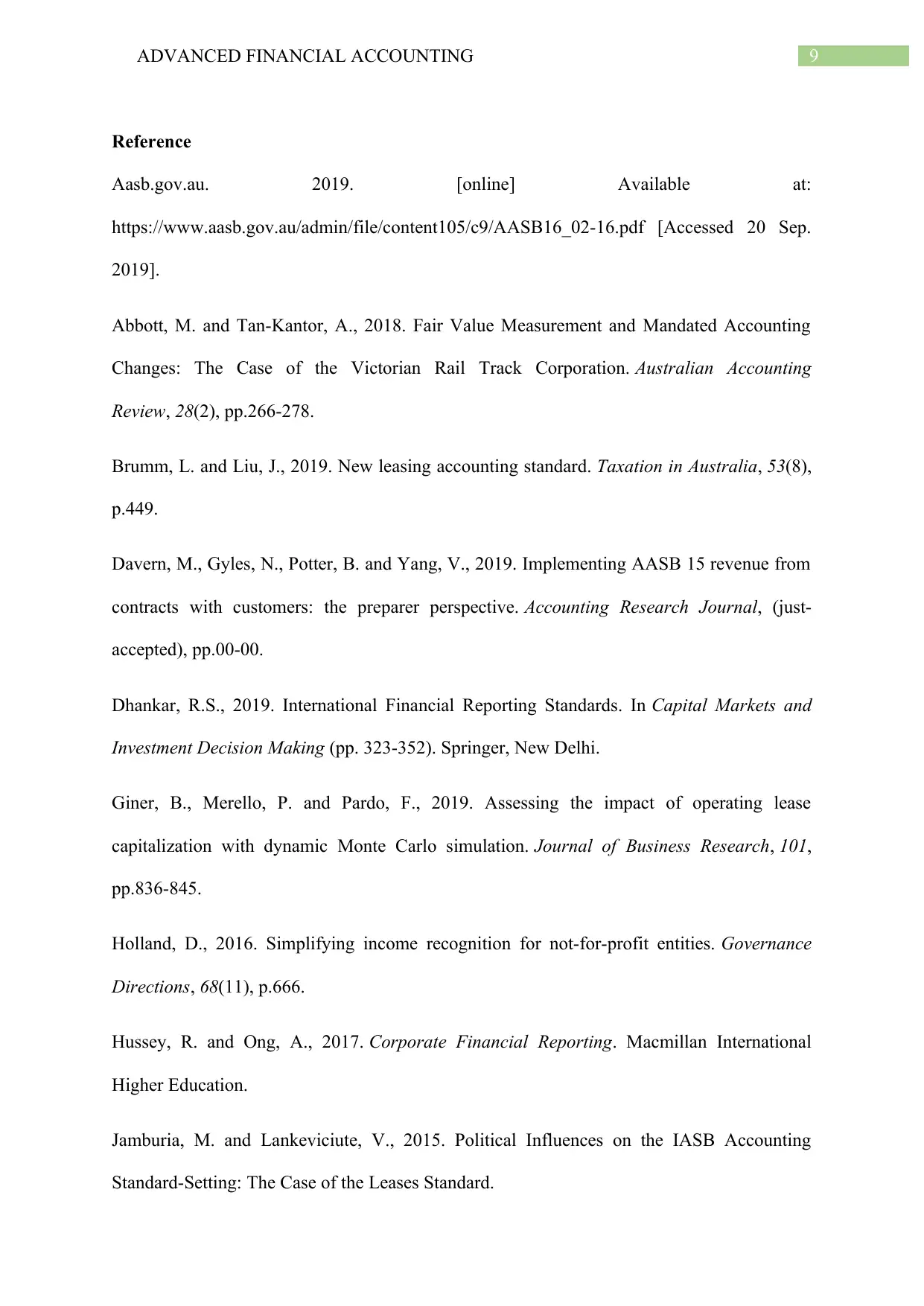
9ADVANCED FINANCIAL ACCOUNTING
Reference
Aasb.gov.au. 2019. [online] Available at:
https://www.aasb.gov.au/admin/file/content105/c9/AASB16_02-16.pdf [Accessed 20 Sep.
2019].
Abbott, M. and Tan‐Kantor, A., 2018. Fair Value Measurement and Mandated Accounting
Changes: The Case of the Victorian Rail Track Corporation. Australian Accounting
Review, 28(2), pp.266-278.
Brumm, L. and Liu, J., 2019. New leasing accounting standard. Taxation in Australia, 53(8),
p.449.
Davern, M., Gyles, N., Potter, B. and Yang, V., 2019. Implementing AASB 15 revenue from
contracts with customers: the preparer perspective. Accounting Research Journal, (just-
accepted), pp.00-00.
Dhankar, R.S., 2019. International Financial Reporting Standards. In Capital Markets and
Investment Decision Making (pp. 323-352). Springer, New Delhi.
Giner, B., Merello, P. and Pardo, F., 2019. Assessing the impact of operating lease
capitalization with dynamic Monte Carlo simulation. Journal of Business Research, 101,
pp.836-845.
Holland, D., 2016. Simplifying income recognition for not-for-profit entities. Governance
Directions, 68(11), p.666.
Hussey, R. and Ong, A., 2017. Corporate Financial Reporting. Macmillan International
Higher Education.
Jamburia, M. and Lankeviciute, V., 2015. Political Influences on the IASB Accounting
Standard-Setting: The Case of the Leases Standard.
Reference
Aasb.gov.au. 2019. [online] Available at:
https://www.aasb.gov.au/admin/file/content105/c9/AASB16_02-16.pdf [Accessed 20 Sep.
2019].
Abbott, M. and Tan‐Kantor, A., 2018. Fair Value Measurement and Mandated Accounting
Changes: The Case of the Victorian Rail Track Corporation. Australian Accounting
Review, 28(2), pp.266-278.
Brumm, L. and Liu, J., 2019. New leasing accounting standard. Taxation in Australia, 53(8),
p.449.
Davern, M., Gyles, N., Potter, B. and Yang, V., 2019. Implementing AASB 15 revenue from
contracts with customers: the preparer perspective. Accounting Research Journal, (just-
accepted), pp.00-00.
Dhankar, R.S., 2019. International Financial Reporting Standards. In Capital Markets and
Investment Decision Making (pp. 323-352). Springer, New Delhi.
Giner, B., Merello, P. and Pardo, F., 2019. Assessing the impact of operating lease
capitalization with dynamic Monte Carlo simulation. Journal of Business Research, 101,
pp.836-845.
Holland, D., 2016. Simplifying income recognition for not-for-profit entities. Governance
Directions, 68(11), p.666.
Hussey, R. and Ong, A., 2017. Corporate Financial Reporting. Macmillan International
Higher Education.
Jamburia, M. and Lankeviciute, V., 2015. Political Influences on the IASB Accounting
Standard-Setting: The Case of the Leases Standard.
Paraphrase This Document
Need a fresh take? Get an instant paraphrase of this document with our AI Paraphraser
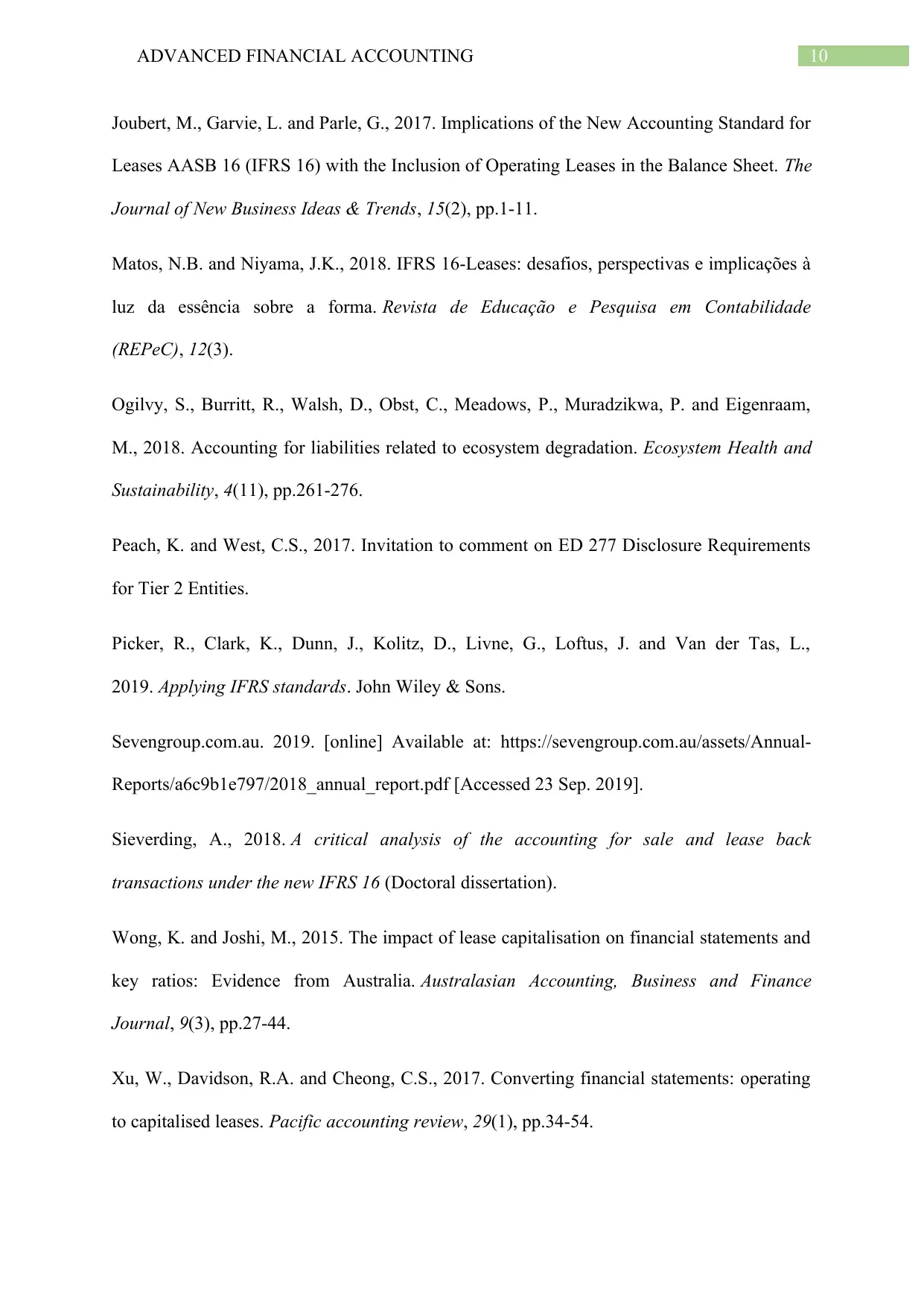
10ADVANCED FINANCIAL ACCOUNTING
Joubert, M., Garvie, L. and Parle, G., 2017. Implications of the New Accounting Standard for
Leases AASB 16 (IFRS 16) with the Inclusion of Operating Leases in the Balance Sheet. The
Journal of New Business Ideas & Trends, 15(2), pp.1-11.
Matos, N.B. and Niyama, J.K., 2018. IFRS 16-Leases: desafios, perspectivas e implicações à
luz da essência sobre a forma. Revista de Educação e Pesquisa em Contabilidade
(REPeC), 12(3).
Ogilvy, S., Burritt, R., Walsh, D., Obst, C., Meadows, P., Muradzikwa, P. and Eigenraam,
M., 2018. Accounting for liabilities related to ecosystem degradation. Ecosystem Health and
Sustainability, 4(11), pp.261-276.
Peach, K. and West, C.S., 2017. Invitation to comment on ED 277 Disclosure Requirements
for Tier 2 Entities.
Picker, R., Clark, K., Dunn, J., Kolitz, D., Livne, G., Loftus, J. and Van der Tas, L.,
2019. Applying IFRS standards. John Wiley & Sons.
Sevengroup.com.au. 2019. [online] Available at: https://sevengroup.com.au/assets/Annual-
Reports/a6c9b1e797/2018_annual_report.pdf [Accessed 23 Sep. 2019].
Sieverding, A., 2018. A critical analysis of the accounting for sale and lease back
transactions under the new IFRS 16 (Doctoral dissertation).
Wong, K. and Joshi, M., 2015. The impact of lease capitalisation on financial statements and
key ratios: Evidence from Australia. Australasian Accounting, Business and Finance
Journal, 9(3), pp.27-44.
Xu, W., Davidson, R.A. and Cheong, C.S., 2017. Converting financial statements: operating
to capitalised leases. Pacific accounting review, 29(1), pp.34-54.
Joubert, M., Garvie, L. and Parle, G., 2017. Implications of the New Accounting Standard for
Leases AASB 16 (IFRS 16) with the Inclusion of Operating Leases in the Balance Sheet. The
Journal of New Business Ideas & Trends, 15(2), pp.1-11.
Matos, N.B. and Niyama, J.K., 2018. IFRS 16-Leases: desafios, perspectivas e implicações à
luz da essência sobre a forma. Revista de Educação e Pesquisa em Contabilidade
(REPeC), 12(3).
Ogilvy, S., Burritt, R., Walsh, D., Obst, C., Meadows, P., Muradzikwa, P. and Eigenraam,
M., 2018. Accounting for liabilities related to ecosystem degradation. Ecosystem Health and
Sustainability, 4(11), pp.261-276.
Peach, K. and West, C.S., 2017. Invitation to comment on ED 277 Disclosure Requirements
for Tier 2 Entities.
Picker, R., Clark, K., Dunn, J., Kolitz, D., Livne, G., Loftus, J. and Van der Tas, L.,
2019. Applying IFRS standards. John Wiley & Sons.
Sevengroup.com.au. 2019. [online] Available at: https://sevengroup.com.au/assets/Annual-
Reports/a6c9b1e797/2018_annual_report.pdf [Accessed 23 Sep. 2019].
Sieverding, A., 2018. A critical analysis of the accounting for sale and lease back
transactions under the new IFRS 16 (Doctoral dissertation).
Wong, K. and Joshi, M., 2015. The impact of lease capitalisation on financial statements and
key ratios: Evidence from Australia. Australasian Accounting, Business and Finance
Journal, 9(3), pp.27-44.
Xu, W., Davidson, R.A. and Cheong, C.S., 2017. Converting financial statements: operating
to capitalised leases. Pacific accounting review, 29(1), pp.34-54.
1 out of 11
Related Documents
Your All-in-One AI-Powered Toolkit for Academic Success.
+13062052269
info@desklib.com
Available 24*7 on WhatsApp / Email
![[object Object]](/_next/static/media/star-bottom.7253800d.svg)
Unlock your academic potential
Copyright © 2020–2025 A2Z Services. All Rights Reserved. Developed and managed by ZUCOL.





